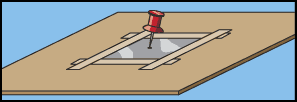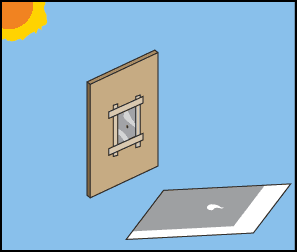| What
to Do |
 |
Cut
a square about 3/4 x 3/4-inch (2 x 2 centimeters) out of the center
of the cardboard.

|
 |
Place
the piece of aluminum foil over the opening and tape it in place at
the edges. |
 |
Using
the pin or other sharp point, puncture the foil to produce a small
hole. You now have a pinhole viewer.

|
|
E
X P E R I M E N T 1
Viewing
an Image of a Candle
|
 |
To
test your pinhole viewer, set up the candle about 4 inches (10 centimeters)
away from one face of the pinhole viewer. |
 |
Light
the candle. |
 |
Turn
out the lights in the room. |
 |
Hold
a white sheet of paper a few inches or centimeters away from the
opposite side of the pinhole viewer. You should be able to see an
image of the flame projected on the paper.

|
| |
Discuss
with your family what happens to the size of the image as you move
the paper farther away. What happens as you move the candle farther
away? |
|
E
X P E R I M E N T 2
Measuring
the Size of the Sun
|
 |
Hold
the pinhole viewer so that the light from the Sun passes through
the hole and falls on a sheet of white paper held behind the hole.
Try to make the distance between the pinhole and the paper as large
as possible.

|
 |
Using
your ruler, measure:
a.
The diameter of the image of the Sun on the paper =
b. The distance from the pinhole to the paper =
|
 |
You
can calculate the diameter of the Sun using the following formula:
|
Diameter
of the image of the Sun
Distance
from the pinhole to the paper
|
.X.
|
Distance
from Earth to the Sun
|
.=.
|
Diameter
of the Sun
|
Note:
The distance from the Earth to the Sun is approximately 93,000,000
miles (149,600,000 kilometers).
|
|
E
X P E R I M E N T 3
Measuring
the Size of the Moon
|
| |
You
can use the same procedure to measure the diameter of the moon. You'll
need to pick a night with a full (or near full) moon.
Note: The distance to the Moon is approximately
239,000 miles (384,000 kilometers).
You might want to discuss how many times larger the Sun is than the
Moon. Also, why if the Sun is so much larger, doesn't it appear larger
in the sky? |
|
What's Going On
The
pinhole viewer you built can project a variety of light sources.
More complex pinhole viewers and cameras use a dark chamber behind
the pinhole. This allows for the projection of images from sources
that are not as bright as the ones used in this exercise. In a basic
way, this is how cameras work.
|
|
|
| This
activity was derived from
"Finding the Size of the Sun and the Moon": from Living and Learning
in the Space Age, by Jeff Crelinsten. Copyright 1988. |


